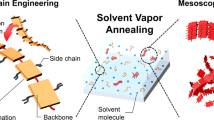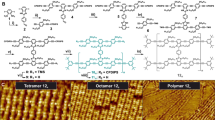Abstract
Applications of conjugated polymers (CP) in organic electronic devices such as light-emitting diodes and solar cells depend critically on the nature of electronic energy transport in these materials1,2,3,4,5. Single-molecule spectroscopy has revealed their fundamental properties with molecular detail6,7,8,9,10,11,12,13,14, and recent reports suggest that energy transport in single CP chains can extend over extraordinarily long distances of up to 75 nm (refs 13, 15, 16). An important question arises as to whether these characteristics are sustained when CP chains agglomerate into a neat solid2. Here, we demonstrate that the electronic energy transport in aggregates composed of tens of polymer chains takes place on a similar distance scale as that in single chains. A recently developed molecular-level understanding of solvent vapour annealing has allowed us to develop a technique to control the CP agglomeration process17. Aggregates with volumes of at least 45,000 nm3 (molecular weight ≈ 21 MDa) maintain a highly ordered morphology and show pronounced fluorescence blinking behaviour, indicative of substantially long-range energy transport. Our findings provide a new lens through which the ordering of single CP chains and the evolution of their morphological and optoelectronic properties can be observed, which will ultimately enable the rational design of improved CP-based devices.
This is a preview of subscription content, access via your institution
Access options
Subscribe to this journal
Receive 12 print issues and online access
$259.00 per year
only $21.58 per issue
Buy this article
- Purchase on Springer Link
- Instant access to full article PDF
Prices may be subject to local taxes which are calculated during checkout





Similar content being viewed by others
References
Shaheen, S. E. et al. 2.5% efficient organic plastic solar cells. Appl. Phys. Lett. 78, 841–843 (2001).
Bardeen, C. Exciton quenching and migration in single conjugated polymers. Science 331, 544–545 (2011).
Wang, H. L., MacDiarmid, A. G., Wang, Y. Z., Gebler, D. D. & Epstein, A. J. Application of polyaniline (emeraldine base, EB) in polymer light-emitting devices. Synth. Met. 78, 33–37 (1996).
Hide, F., DiazGarcia, M. A., Schwartz, B. J. & Heeger, A. J. New developments in the photonic applications of conjugated polymers. Acc. Chem. Res. 30, 430–436 (1997).
Friend, R. H. et al. Electroluminescence in conjugated polymers. Nature 397, 121–128 (1999).
VandenBout, D. A. et al. Discrete intensity jumps and intramolecular electronic energy transfer in the spectroscopy of single conjugated polymer molecules. Science 277, 1074–1077 (1997).
Yu, J., Hu, D. H. & Barbara, P. F. Unmasking electronic energy transfer of conjugated polymers by suppression of O2 quenching. Science 289, 1327–1330 (2000).
Hu, D. H. et al. Collapse of stiff conjugated polymers with chemical defects into ordered, cylindrical conformations. Nature 405, 1030–1033 (2000).
Barbara, P. F., Gesquiere, A. J., Park, S. J. & Lee, Y. J. Single-molecule spectroscopy of conjugated polymers. Acc. Chem. Res. 38, 602–610 (2005).
Muls, B. et al. Direct measurement of the end-to-end distance of individual polyfluorene polymer chains. ChemPhysChem 6, 2286–2294 (2005).
Laquai, F., Park, Y. S., Kim, J. J. & Basche, T. Excitation energy transfer in organic materials: From fundamentals to optoelectronic devices. Macromol. Rapid Commun. 30, 1203–1231 (2009).
Woll, D. et al. Polymers and single molecule fluorescence spectroscopy, what can we learn? Chem. Soc. Rev. 38, 313–328 (2009).
Adachi, T. et al. Highly ordered single conjugated polymer chain rod morphologies. J. Phys. Chem. C 114, 20896–20902 (2010).
Lupton, J. M. Single-molecule spectroscopy for plastic electronics: Materials analysis from the bottom-up. Adv. Mater. 22, 1689–1721 (2010).
Bolinger, J. C., Traub, M. C., Adachi, T. & Barbara, P. F. Ultralong-range polaron-induced quenching of excitons in isolated conjugated polymers. Science 331, 565–567 (2011).
Habuchi, S., Onda, S. & Vacha, M. Mapping the emitting sites within a single conjugated polymer molecule. Chem. Commun. 4868–4870 (2009).
Vogelsang, J., Brazard, J., Adachi, T., Bolinger, J. C. & Barbara, P. F. Watching the annealing process one polymer chain at a time. Angew. Chem. Int. Ed. 50, 2257–2261 (2011).
Lifschitz, I. M. & Slyozov, V. V. The kinetics of precipitation from supersaturated solid solutions. J. Phys. Chem. Solids 19, 35–50 (1961).
Brandrup, J., Immergut, E. H., Grulke, E. A., Abe, A. & Bloch, D. R. Polymer Handbook 4th edn (Wiley, 1999).
Traiphol, R., Sanguansat, P., Srikhirin, T., Kerdcharoen, T. & Osotchan, T. Spectroscopic study of photophysical change in collapsed coils of conjugated polymers: Effects of solvent and temperature. Macromolecules 39, 1165–1172 (2006).
Peng, J. et al. Morphologies in solvent-annealed thin films of symmetric diblock copolymer. J. Chem. Phys. 125, 064702 (2006).
Grey, J. K., Kim, D. Y., Norris, B. C., Miller, W. L. & Barbara, P. F. Size-dependent spectroscopic properties of conjugated polymer nanoparticles. J. Phys. Chem. B 110, 25568–25572 (2006).
Szymanski, C. et al. Single molecule nanoparticles of the conjugated polymer MEH–PPV, preparation and characterization by near-field scanning optical microscopy. J. Phys. Chem. B 109, 8543–8546 (2005).
Markov, D. E., Amsterdam, E., Blom, P. W. M., Sieval, A. B. & Hummelen, J. C. Accurate measurement of the exciton diffusion length in a conjugated polymer using a heterostructure with a side-chain cross-linked fullerene layer. J. Phys. Chem. A 109, 5266–5274 (2005).
Samuel, I. D. W. & Turnbull, G. A. Organic semiconductor lasers. Chem. Rev. 107, 1272–1295 (2007).
van der Veen, M. H., de Boer, B., Stalmach, U., van de Wetering, K. I. & Hadziioannou, G. Donor–acceptor diblock copolymers based on PPV and C60: Synthesis, thermal properties, and morphology. Macromolecules 37, 3673–3684 (2004).
Lindner, S. M., Huttner, S., Chiche, A., Thelakkat, M. & Krausch, G. Charge separation at self-assembled nanostructured bulk interface in block copolymers. Angew. Chem. Int. Ed. 45, 3364–3368 (2006).
Zhang, Q. L., Cirpan, A., Russell, T. P. & Emrick, T. Donor–acceptor poly(thiophene-block-perylene diimide) copolymers: Synthesis and solar cell fabrication. Macromolecules 42, 1079–1082 (2009).
Yang, C., Lee, J. K., Heeger, A. J. & Wudl, F. Well-defined donor–acceptor rod-coil diblock copolymers based on P3HT containing C60: The morphology and role as a surfactant in bulk-heterojunction solar cells. J. Mater. Chem. 19, 5416–5423 (2009).
Acknowledgements
This material is based on work supported as part of the program ‘Understanding Charge Separation and Transfer at Interfaces in Energy Materials (EFRC:CST)’, an Energy Frontier Research Center funded by the US Department of Energy, Office of Science, Office of Basic Energy Sciences under Award Number DE-SC0001091. J.V. thanks the German Research Foundation (DFG) for a fellowship. We thank G. Lakhwani for stimulating discussions and O. Fabian for proofreading the manuscript.
Author information
Authors and Affiliations
Contributions
J.V. performed and analysed experiments. T.A. analysed experiments and performed simulations. J.B. prepared samples and performed experiments. J.V., D.A.V.B. and P.F.B. designed experiments. J.V., T.A. and D.A.V.B. wrote the paper.
Corresponding authors
Ethics declarations
Competing interests
The authors declare no competing financial interests.
Supplementary information
Supplementary Information
Supplementary Information (PDF 701 kb)
Supplementary Information
Supplementary Movie (AVI 7048 kb)
Supplementary Information
Supplementary Movie (AVI 5753 kb)
Supplementary Information
Supplementary Movie (AVI 5863 kb)
Supplementary Information
Supplementary Movie (AVI 6546 kb)
Supplementary Information
Supplementary Movie (AVI 6887 kb)
Supplementary Information
Supplementary Movie (AVI 7646 kb)
Supplementary Information
Supplementary Movie (AVI 8259 kb)
Supplementary Information
Supplementary Movie (AVI 5984 kb)
Supplementary Information
Supplementary Movie (AVI 6871 kb)
Supplementary Information
Supplementary Movie (AVI 7539 kb)
Supplementary Information
Supplementary Movie (AVI 9542 kb)
Supplementary Information
Supplementary Movie (AVI 8944 kb)
Rights and permissions
About this article
Cite this article
Vogelsang, J., Adachi, T., Brazard, J. et al. Self-assembly of highly ordered conjugated polymer aggregates with long-range energy transfer. Nature Mater 10, 942–946 (2011). https://doi.org/10.1038/nmat3127
Received:
Accepted:
Published:
Issue Date:
DOI: https://doi.org/10.1038/nmat3127
This article is cited by
-
Aggregates of conjugated polymers: bottom-up control of mesoscopic morphology and photophysics
NPG Asia Materials (2023)
-
Anisotropic energy transfer in crystalline chromophore assemblies
Nature Communications (2018)
-
Switching between H- and J-type electronic coupling in single conjugated polymer aggregates
Nature Communications (2017)
-
Controlling photophysical properties of ultrasmall conjugated polymer nanoparticles through polymer chain packing
Nature Communications (2017)
-
Long-range energy transport in single supramolecular nanofibres at room temperature
Nature (2015)



